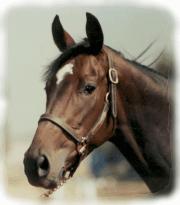A Horse, of Course with Don Blazer |
If you enjoy learning about horses, then you'll love our online courses. Each month you'll find a new column on our web site. We hope you'll enjoy it, and maybe e-mail us with questions or suggestions for other columns. A Horse, Of Course is a monthly column syndicated by Success Is Easy. If you like the column, call your local newspaper, or local horse publication and ask them to subscribe by contacting Success Is Easy. |
It's a Shame About Dressage Don Blazer copyright©2010 It’s a shame about dressage. Or at least to me it is. I always thought of it as such a “pure” thing; such a “beautiful thing; harmony in union.” For me, Dressage was practiced by those who wanted “art with horses.” It was for horsemen and women who wanted to take a horse to his maximum performance ability, suppleness, flexibility, balance and grace. It was a work of art between a rider and a horse, and that is all that it had to be. It was, but it is no more. Dressage: a noun, French, originally meaning “basic dressing.” The basic dressing was applied to all horses and at all levels and that was the extent of it. It was done with any horse that a nobleman (and only noblemen could afford both the luxury of a horse and the time to develop its gaits, grace, balance, suppleness and flexibility) saw fit to ride. The idea originally was not to compare horses, but to enjoy the development of a single horse’s unique talents. One horse and one rider, being all they could be. And that was the original goal. Then disaster struck; dressage became a competition. One of my most admired dressage authorities, Waldemar Seunig (he attended the French Cavalry School at Saumur and the Spanish Riding School at Vienna and from 1922 to 1930 was the Master of the Horse at the Court of King Alexander of Yugoslavia; he was the coach of the successful German Olympic Team.) says this about perfecting the art of dressage: “it is the practical, creative artist, the equestrian genius, who is fused with his horse into one unit, who makes its will his own, and who proves that there are no limits to art.” Great thinking….and he could do it…and many in the 1600s, 1700s, 1800s could do it……but by the 1900s competition had corrupted that simple idea of dressage for the sake of dressage. Seunig was not only an equestrian competitor, he was a judge of international competition. He too was corrupted, and winning became more important than dressage. But in the 1950s and 1960s, dressage was still defined as training, exhibition riding or horsemanship in which the horse is controlled in certain difficult steps and gaits by very light movements of the rider. The horse is to be relaxed and the performance is to appear “effortless.” Light and gently and subtle were the key words for dressage riders such as Colonel Alois Podhajsky, Jessica Newberry and later Reiner Klimke, a world champion and winner of 6 gold medals in 5 Olympics (1964 to 1988) When I see pictures of Podhajsky and Newberry riding, or I watch Klimke ride, I see a horse that is relaxed and appears to be performing effortlessly. I see a rider not strained or stesssed or rigid, but in a beautifully balanced position with a willing partner. It’s a shame about dressage. When I see upper level riders today, the art is gone. Don’t misunderstand me. It is not that I am not in awe of the performances they achieve. They are getting more from their horses than the past masters did. (Of course, the horses they are riding have evolved along with training knowledge and techniques.) What I see in today’s advanced level dressage are horses performing phenomenally; they are giving every ounce of effort they have to give. They are reaching new heights in suppleness and flexibility. And they are unhappy, tense and showing the exertion needed to respond to their rider’s demands. Nothing about it appears “effortless.” It is not light or gentle or subtle. I watched a video of a horse score the highest dressage score ever recorded. The maneuvers were fantastic and the accomplishments of the horse should be applauded again and again. But the horse hated every minute of that performance; the tail wringing and swishing and twirling and shaking, the ears back, the face knotted with tension. It wasn’t the art I had hoped it would be…it was man forcing his will onto the horse in the name of competition. Oh, for the original idea of any horse being helped to reach his potential, with no intention of ever comparing one horse to another. It’s a shame about dressage. Visit A Horse, Of Course on the Internet at www.donblazer.com |
